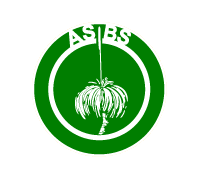
ASBS Newsletter – Book Review
Flora of Australia Volume 17B,
Proteaceae 3, Hakea to Dryandra
(From ASBS Newsletter Number 100, September 1999)
Melbourne: ABRS/CSIRO Australia (1999)
Volume 17B of the Flora of Australia covers some critical genera of the Proteaceae, Hakea, Dryandra and the small rainforest genera Austromuellera and Musgravea. The treatment of Dryandra is very welcome, with this difficult genus now presented in its (current) entirety in one place. However, I want to focus on the only genus that receives a lengthy introduction - Hakea. Both the introduction to this genus and the taxonomic treatment are the result of a lot of work by Bill and Robyn Barker and Laurie Haegi. I won't call this a culmination, since they make it very clear in the introductory section that their work on Hakea is far from complete. Nevertheless, they pull together a large amount of data, much of it their own, in a wide-ranging review of what is known about this genus.
Like most proteaceous genera, Hakea becomes more fascinating the more it is studied, and this chapter provides much food for thought, plenty of room for debate, and enough research ideas to keep many people occupied well into the future. I would like to concentrate on a few of these, which I choose because they happen to be of particular interest to me.
A particular focus of interest in Tasmania over the last few years has been the apparently ancient nature of some individual plants. One is the Huon Pine (Lagarostrobos franklinii - Podocarpaceae) which is a sorry story of half-baked science turned into a sensational story by the media. This may end up causing major damage to the entire area where it occurs if, as seems likely, tourists are allowed on to the Mt Read summit to see this (allegedly 10,000 year old) plant. However, the other is far more legitimate. Lynch et al. (1998) reported that Lomatia tasmanica produces sterile flowers and only reproduces vegetatively. Its current geographic spread suggests a very ancient origin for what was almost certainly a single plant in the first place, and fragmentary fossil evidence suggests an age in excess of 43,000 years. Barker et al. add two species of Hakea to this list of proteaceous species with sterile flowers. Hakea aenigma now covers an area of 30 x 15 km and regenerates via underground suckers from horizontal roots, while H. pulvinifera occurs on a single small hillside. They also note a species of Grevillea with a similar reproductive syndrome. This seems a very productive area for research. While mechanisms for the production of these plants in the first place obviously exist, tests for them will be hard to conceive and even harder to apply. However, the question of why at least some of these plants have been so successful and spread to such large areas is well worth investigating.
An aspect of Hakea that has clearly captured the interest of the authors is the way in which various species have evolved protection against herbivory. They note camouflage of fruits in a variety of ways and protection of fruits by spiky leaves in some species. They provide the innovative hypothesis that mimicry in developing fruits may provide a defence against predation of Hakea seed. They suggest that horns produced on some Hakea fruits closely resemble those on the larvae of a geometrid moth that feeds on the plant (but not the seeds). This resemblance is most striking when a larva is disturbed and arches out from the twig in a defensive aggressive posture. Black cockatoos like to eat Hakea seed and Barker et al. note that the response of these birds to the moth larvae would be interesting to observe. That is, if they avoid them, then the plant may gain by mimicking them. This has not been tested, but it would make a great research project in evolutionary theory.
Finally, I can't resist commenting on the suggested interaction between Hakea and the megafauna. Barker et al. believe that rigid, spine-tipped or margined leaves which characterise not only Hakea but also many other groups in the Australian heaths may have been selected in response to browsing. They also suggest that the long ascending branches ringed by sharp terete leaves, that are characteristic of several species scattered throughout the genus, may be a defensive response to browsing. This makes an interesting comparison with Tim Flannery's (1994) hypothesis about the interaction of between the megafauna (or more specifically the megaherbivores) and the scleromorphic vegetation. For Flannery's hypothesis to work, the main food for the megaherbivores was not the scleromorphic vegetation, but other, more nutrient-rich vegetation, which was severely depleted by fire due to excessive fuel build-up once the megaherbivores were extinct. Of course, part of the reason why the megaherbivores did not favour scleromorphic vegetation as a food source may have been because it had well developed mechanical defences, such as are described in this book. As the authors note, there is abundant scope for imaginative research on the potential interactions among the living Australian flora and the extinct megaherbivores which at present is largely untouched.
I commend this book to anyone who is looking for inspiration about what lateral thinking can do in the hands of herbarium taxonomists. It also goes without saying that this is an invaluable addition to the Flora of Australia series, adding a large degree of completeness to one of our most important families.
Reviewer: Bob Hill
Environmental Biology
University of Adelaide